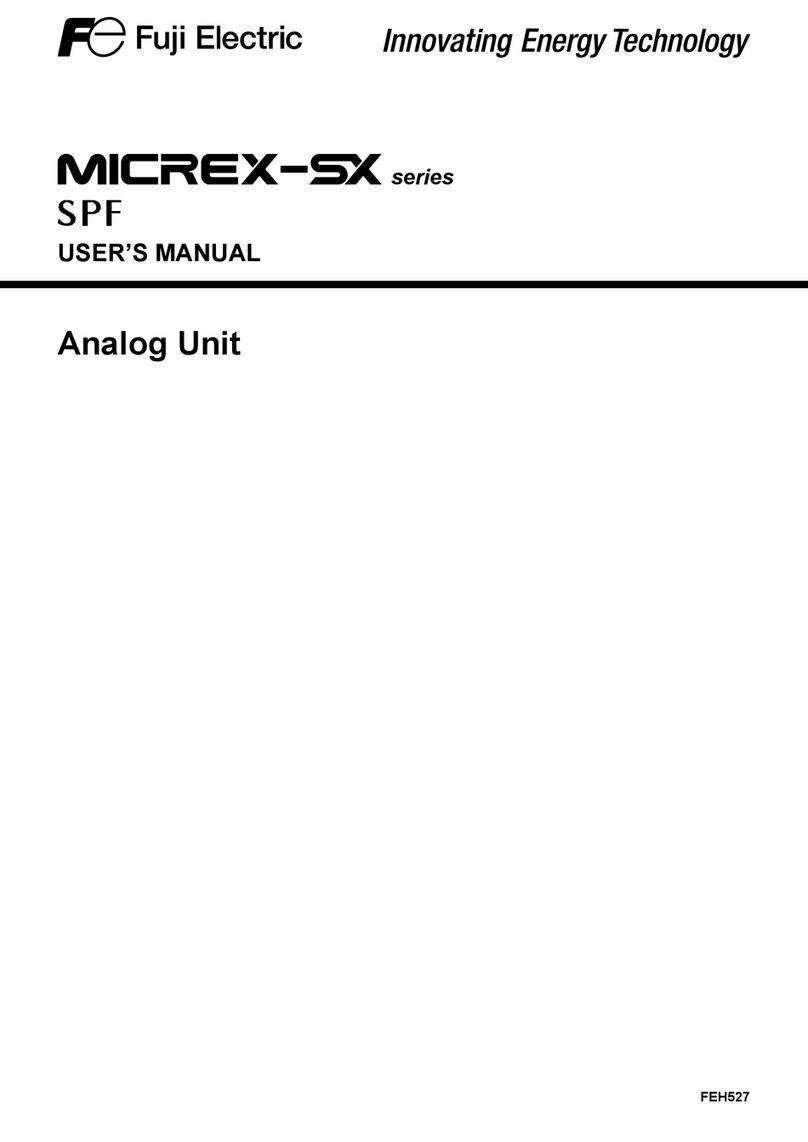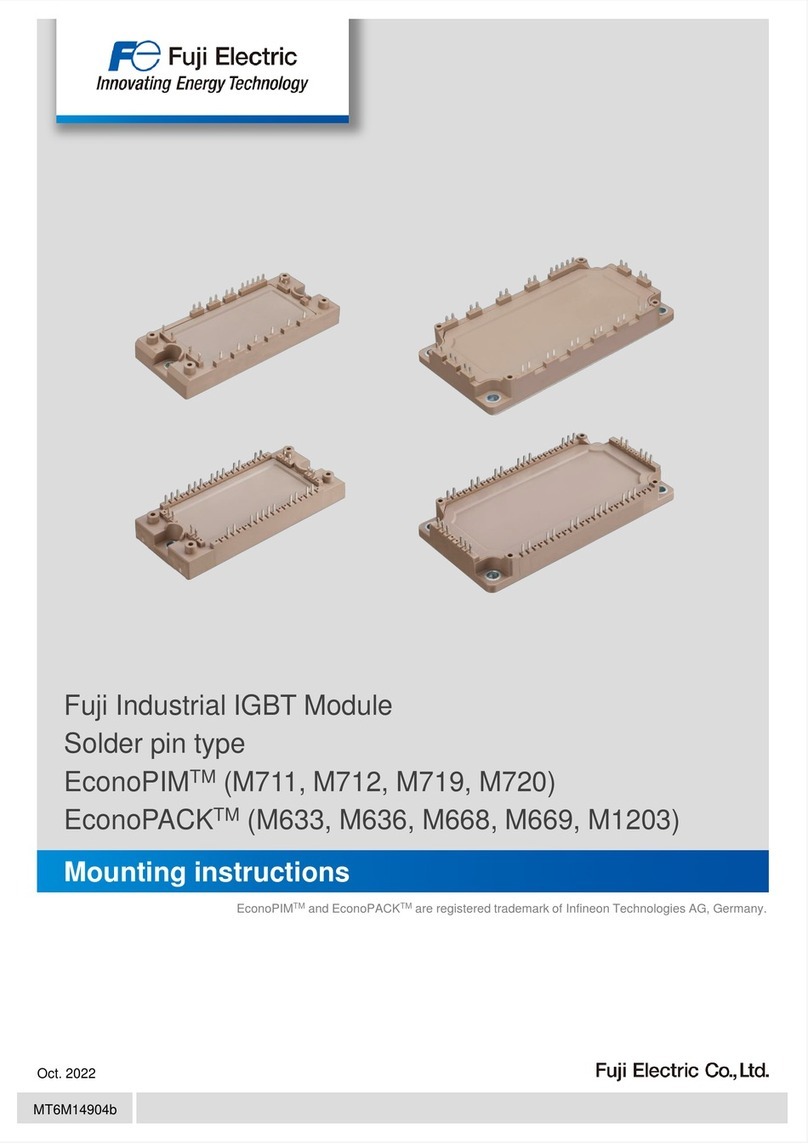Fuji Electric BUC-D Series User manual

Instruction Manual
Stack Type Dynamic Braking Unit
BUC-D Series (690V Type)
Thank you for purchasing our dynamic braking unit (BUC-D Series).
• This product is a device to discharge the braking power to a resistor in a braking operation of the Fuji's inverter for
general industry. Read through this instruction manual to become familiar with proper handling and correct use.
• Improper handling might result in incorrect operation, a short life, or even a failure of this product.
• Deliver this manual to the end user of this product. Keep this manual in a safe place until this product is discarded.
• For the installation and selection of peripheral equipment exclusive to the stack type of inverters, refer to the
FRENIC-VG User's Manual (Stack Type Edition).
• For the configuration of the inverter functions and operating procedure, refer to the FRENIC-VG User's Manual (Unit
Type / Function Codes Edition).
• For details about PWM converters and diode rectifiers, refer to the FRENIC-VG User's Manual (Stack Type Edition).
Fuji Electric Co., Ltd. INR-SI47-1846-E

Copyright © 2014 Fuji Electric Co., Ltd.
All rights reserved.
No part of this publication may be reproduced or copied without prior written permission
from Fuji Electric Co., Ltd.
All products and company names mentioned in this manual are trademarks or registered
trademarks of their respective holders.
The information contained herein is subject to change without prior notice for
improvement.

Preface
Thank you for purchasing our dynamic braking unit (BUC-D Series).This product is a device to discharge the braking power
to a resistor in a braking operation of the Fuji's inverter for general industry.
Read through this instruction manual to become familiar with proper handling for correct use. Improper handling might result
in incorrect operation, a short life, or even a failure of this product as well as the motor.
The related documents are subject to change without notice. Be sure to obtain the latest editions for use.
List of applicable inverters
The table below lists the inverters that can be used in combination with this product.
Inverter series Capacity Inverter type Stack/unit type
VG series All capacities FRNSVG1S-69Stack type
Table of Contents
Preface i
Safety precautions ................................................................................................................................................................. iii
Chapter 1 BEFORE USE ......................................................................................................................................................... 1
1.1 Acceptance Inspection.................................................................................................................................................. 1
1.2 External Appearance..................................................................................................................................................... 2
1.3 Precautions for Using dynamic breaking unit............................................................................................................... 3
1.3.1 Installation environment .......................................................................................................................................3
1.3.2 Storage environment .............................................................................................................................................5
[ 1 ] Temporary storage ................................................................................................................................................5
[ 2 ] Long-term storage.................................................................................................................................................5
Chapter 2 MOUNTING AND WIRING .................................................................................................................................. 6
2.1 Mounting the dynamic breaking unit............................................................................................................................ 6
2.1.1 Terminal Arrangement and Screw Sizes (Main circuit terminals).........................................................................7
[ 1 ] Rank 4 (500 kW)................................................................................................................................................7
2.2 Wiring........................................................................................................................................................................... 8
2.2.1 Connection diagram..............................................................................................................................................8
2.2.2 Removing and mounting the front cover and the wiring guide...........................................................................10
2.2.3 Basic Connections...............................................................................................................................................11
2.2.4 Main circuit terminals.........................................................................................................................................11
[ 1 ] Screw specifications and recommended wire sizes (main circuit terminals) ....................................................11
[ 2 ] Terminal functions (main circuit terminals) .....................................................................................................12
2.2.5 Control circuit terminals .....................................................................................................................................12
[ 1 ] Screw specifications and recommended wire sizes (control circuit terminals)................................................12
[ 2 ] Terminal arrangement (control circuit terminals) .............................................................................................12
[ 3 ] Detailed functions of control circuit terminals .................................................................................................13
[ 4 ] Wiring for the control circuit............................................................................................................................16
2.2.6 Setting up the slide switches ...............................................................................................................................18
2.2.7 Fan power switching connector CN UX .............................................................................................................19
2.2.8 Connecting optical fiber cable ............................................................................................................................20
Chapter 3 TEST RUN PROCEDURE.................................................................................................................................... 21
3.1 Checking Prior to Powering On.................................................................................................................................. 21
3.2 Powering ON and Checking ....................................................................................................................................... 21
Chapter 4 TROUBLESHOOTING ........................................................................................................................................ 21
4.1 Protective Functions ................................................................................................................................................... 21
4.2 Before Proceeding with Troubleshooting ................................................................................................................... 21
4.3 Troubleshooting.......................................................................................................................................................... 22
4.3.1 List of Protective Functions................................................................................................................................22
4.3.2 Possible causes of alarms, checks and measures.................................................................................................22
[ 1 ] Overcurrent ......................................................................................................................................................22
[ 2 ] Overvoltage ......................................................................................................................................................23
[ 3 ] DC Fuse blown.................................................................................................................................................23
[ 4 ] Memory error ...................................................................................................................................................23
i

ii
[ 5 ] CPU error .........................................................................................................................................................23
[ 6 ] Hardware error .................................................................................................................................................24
[ 7 ] Heat sink overheat............................................................................................................................................24
[ 8 ] Dynamic breaking unit internal overheat..........................................................................................................24
[ 9 ] Inter- dynamic breaking unit communications link error .................................................................................24
Chapter 5 MAINTENANCE AND INSPECTION ................................................................................................................ 25
5.1 Inspection Interval ...................................................................................................................................................... 25
5.2 Daily Inspection.......................................................................................................................................................... 25
5.3 Periodic Inspection ..................................................................................................................................................... 26
5.4 List of Periodic Replacement Parts............................................................................................................................. 27
5.5 Insulation Test............................................................................................................................................................. 27
5.6 Inquiries about Product and Guarantee....................................................................................................................... 28
5.6.1 When making an inquiry.....................................................................................................................................28
5.6.2 Product warranty.................................................................................................................................................28
[ 1 ] Free of charge warranty period and warranty range .........................................................................................28
[ 2 ] Exclusion of liability for loss of opportunity, etc. ............................................................................................29
[ 3 ] Repair period after production stop, spare parts supply period (holding period)..............................................29
[ 4 ] Transfer rights ..................................................................................................................................................29
[ 5 ] Service contents................................................................................................................................................29
[ 6 ] Applicable scope of service..............................................................................................................................29
Chapter 6 SPECIFICATIONS................................................................................................................................................ 29

Safety precautions
Read this manual thoroughly before proceeding with installation, connections (wiring), operation, or maintenance and
inspection. Ensure you have sound knowledge of the device and familiarize yourself with all safety information and
precautions before proceeding to operate the inverter.
Safety precautions are classified into the following two categories in this manual.
Failure to heed the information indicated by this symbol may lead to dangerous conditions,
possibly resulting in death or serious bodily injuries.
Failure to heed the information indicated by this symbol may lead to dangerous conditions,
possibly resulting in minor or light bodily injuries and/or substantial property damage.
Failure to heed the information contained under the CAUTION title can also result in serious consequences. These safety
precautions are of utmost importance and must be observed at all times.
Application
• This product is designed to discharge the braking power to a resistor in a braking operation of the Fuji's inverter for
general industry. It cannot be used for others.
Fire or an accident could occur.
• The dynamic braking unit may not be used for a life-support system or other purposes directly related to the human
safety.
• Though the dynamic braking unit is manufactured under strict quality control, install safety devices for applications
where serious accidents or property damages are foreseen in relation to the failure of it.
An accident could occur.
Installation
• Install the dynamic braking unit on a base made of metal or other non-flammable material.
Otherwise, a fire could occur.
• Do not place flammable object nearby.
Doing so could cause fire.
• The dynamic braking unit whose protective structure is IP00 involves a possibility that a human body may touch the
live conductors of the main circuit terminal block. Install the dynamic braking unit in an inaccessible place.
Otherwise, electric shock or injuries could occur.
• Do not support the dynamic braking unit by its front cover during transportation.
Doing so could cause a drop of the inverter and injuries.
• Prevent lint, paper fibers, sawdust, dust, metallic chips, or other foreign materials from getting into the dynamic
braking unit or from accumulating on the heat sink.
• When installing the dynamic braking unit, use screws and bolts specified in the installation procedure and tighten
them with the specified tightening torque.
Otherwise, a fire or an accident might result.
• Do not install or run an dynamic braking unit that is damaged or lacking parts.
Doing so could cause fire, an accident or injuries.
iii
This manual suits for next models
1
Table of contents
Other Fuji Electric Industrial Equipment manuals




















